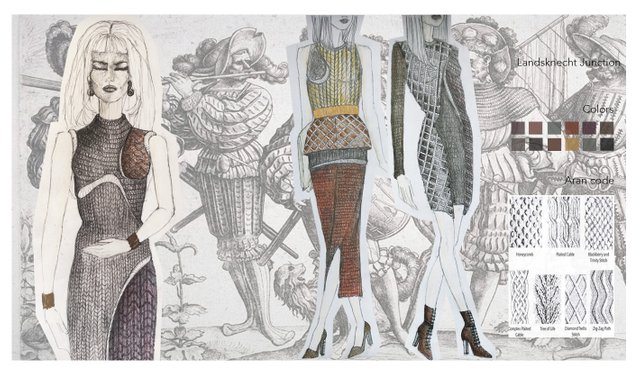Aran Code + Landsknecht Junction
Needlecraft Encyclopedia (Judy Brittain) is a 1970’s comprehensive classic manual on macramé, crochet, embroidery, sewing and knits, from the age when the handwork was part of generation's free time. Image of bearded models wearing Aran and Guernsey sweaters got me vintage feel I had to include in the following recipe for the spring project of reinterpreted knits. I exchanged verbatim instructions from the needlecraft manuals for the improvisation, asymmetry, collage techniques, and all things avant-garde... Until I got the formula:
Ingredients for spring knit:
A bit cubist design thinking
Pattern: Pinch of out-of-the-box tailoring
Texture: Aran / Fair Isle / Guernsey / Bohus
Colors: Warm Brownish-Redish-Greyish
Season with vintage atmosphere (bell-bottoms?)
But eventually, I found a better one.
The Landsknecht were elite mercenary soldiers, predominatly of German origin who were an important military force through late 15th- and 16th-century Europe. Allegedly, they slashed the pieces of clothing from fallen soldiers and made their own picturesque garments.
Conceptually, I joined the technique with the Aran code and got this:

A perfect outfits for casual-eclectic-ladylike-smart days.
These knits originated in the world’s outskirts, a remote island which modernization passed by, and were made by a handful of inhabitants. Fair Isle in northern Scotland counts only 55 human inhabitants, and the number of sheeps is much higher than that.
Isle knits have unusual names
Aran
Aran islands in western Ireland are known for being cliffy and stripped - trees won't grow here. Imagine the sharpness of the wind, but Aran sweater is said to keep you feel safe from the wind&water. Long time ago the Celts left their cultural heritage here - motifs which are used as an inspiration for Aran texture, as well as Christian symbols from the 11th ct. Each family clan had their unique patterns.
The Aran sweater is undyed or sometimes coloured naturally with moss or algae in green or brown. Made from domestic wool and it is waterproof due to wool’s natural water repellent - lanolin. Aran became popular through Vogue 1950’s and 1960’s editorials.
Gansey
Guernsey or 'Gansey' sweater dates back to Elizabethan times when Mary, Queen of Scots is said to have worn a pair of white Guernsey stockings at her execution.
Guernsey sweater is simple, dark-coloured rectangular-shaped garment with comfortable wide sleeves allowing freedom of movement. It is made in one piece in thick wool. The body of the jumper is usually of plain stocking stitch. Just like Aran, knit is thick, durable, it can be worn for a lifetime, and its pattern varies from village to village.
Fair Isle
These knits are known for their coloured patterns, found in many different places in Northern and Baltic Europe. The patterns are made of motifs such as crosses, diamonds and eight-pointed stars. They were popular during the 1920’s fashion, and natural shades like brown, grey and white were preferred. It is unknown where they originated.
I read that these knitting types originated in 19th and 20th century and mostly in the northern area to improve on the household economy of the poor habitants (I thought they developed as a part of the island's culture, and not for profit). According to an article from Ms. Marrianne P. Stopp: ‘’Types such as the Fair Isle sweater took form in northeast Scotland, alongside Irish Aran sweaters, Scottish Argyle knits and Swedish Bohus knits, Cowichan sweater’s from North America among others, and each had its beginnings in mitten and stocking production… They developed out of influences, trial and error, and copying over several sweater generations. (Lambert 2002).’’
The isle knits didn't have single source and neither did I. Joining the Aran codes and the Landsknecht junction technique, means to strip them of the cultural meaning they are assumed to have (and perhaps imagined history that never happened) which is all what modern fashion does.
Congratulations @katarinabar! You have completed the following achievement on the Steem blockchain and have been rewarded with new badge(s) :
Click here to view your Board of Honor
If you no longer want to receive notifications, reply to this comment with the word
STOPDo not miss the last post from @steemitboard:
Congratulations @katarinabar! You have completed the following achievement on the Steem blockchain and have been rewarded with new badge(s) :
Click here to view your Board of Honor
If you no longer want to receive notifications, reply to this comment with the word
STOP